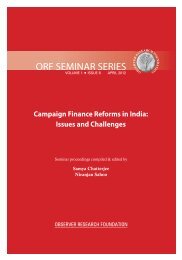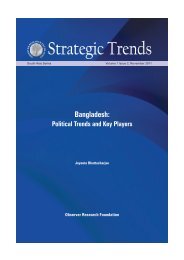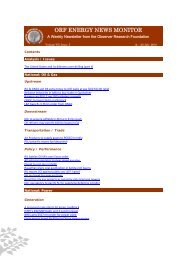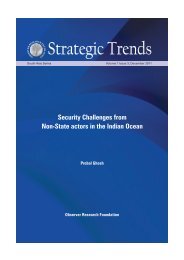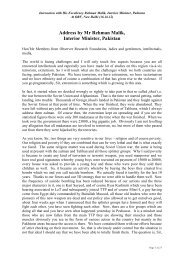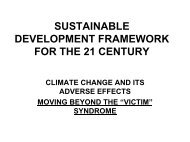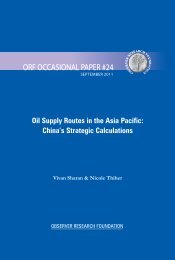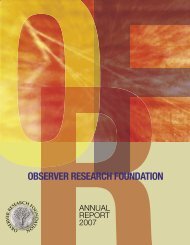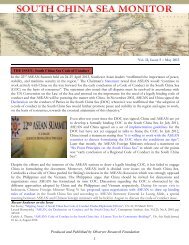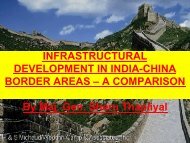Affirmative Action in Private Sector in Malaysia - Observer Research ...
Affirmative Action in Private Sector in Malaysia - Observer Research ...
Affirmative Action in Private Sector in Malaysia - Observer Research ...
You also want an ePaper? Increase the reach of your titles
YUMPU automatically turns print PDFs into web optimized ePapers that Google loves.
Puthucheary, M. (1978). The politics of adm<strong>in</strong>istration: The <strong>Malaysia</strong>n experience. Kuala Lumpur,<br />
<strong>Malaysia</strong>: Oxford University Press.<br />
Ratuva, Steven (2002), <strong>Affirmative</strong> action and Good Governance: Some Lessons for<br />
Vanuatu,a paper presented at “Vanuatu Governance Update – 2002, University of South Pacific,<br />
Vanuatu.<br />
Sabbagh, Daniel (2004): <strong>Affirmative</strong> <strong>Action</strong> Policies: An International Perspective, Occasional<br />
Paper for UNDP Report, 2004<br />
Samad, M Fazilah B<strong>in</strong>ti Abdul, 2003, Bumiputeras <strong>in</strong> Corporate <strong>Malaysia</strong>: Three Decades of<br />
performance, 1970-2000, <strong>in</strong> Edmund Terence Gomez and Robert Stephens (edited) The State,<br />
Economic Development and Ethnic Coexistence <strong>in</strong> <strong>Malaysia</strong> and New Zealand, CEDER.<br />
Searle, Peter. 1999. The Riddle of <strong>Malaysia</strong>n Capitalism: Rent Seekers or real Capitalism?, NSW,<br />
Australia: Allen and Unw<strong>in</strong>.<br />
Shamsul, A.B. 1986. From British to Bumiputera Rule: Local Politics and Rural Development <strong>in</strong> Pen<strong>in</strong>sular<br />
<strong>Malaysia</strong>. S<strong>in</strong>gapore: ISEAS.<br />
Snodgrass, D.R. 1980. Inequality and Economic Development <strong>in</strong> <strong>Malaysia</strong>, Kuala Lumpur: Oxford<br />
University Press.<br />
Tan, Boon Kean, 1993, Role of the Construction <strong>Sector</strong> <strong>in</strong> National Development: <strong>Malaysia</strong>,<br />
Ph.D thesis, University of Malaya.<br />
Thorat, Sukhadeo and Nidhi Sadana, 2009. “Caste and Ownership of <strong>Private</strong> Enterprises”,<br />
Economic and Political Weekly, Vol. XLIV, No.23.<br />
Yusof, Za<strong>in</strong>al Aznam and Deepak Bhattasali, 2009. “Economic Growth and Development <strong>in</strong><br />
<strong>Malaysia</strong>: Policy Mak<strong>in</strong>g and leadership”. Commission on Growth and Development, World Bank<br />
Work<strong>in</strong>g Paper No.27.<br />
1 Broadly conceived, affirmative action is a term that refers to measures or practices that seek to elim<strong>in</strong>ate<br />
discrim<strong>in</strong>atory practices by permitt<strong>in</strong>g the consideration of race, ethnicity, sex, or national orig<strong>in</strong> <strong>in</strong> the<br />
availability of opportunity for a class of qualified <strong>in</strong>dividuals that have been the victims of historical,<br />
actual, or recurr<strong>in</strong>g discrim<strong>in</strong>ation (for details see: Sabbagh, 2004)<br />
2 To elaborate little further, for <strong>in</strong>stance the <strong>Malaysia</strong>n experience can provide useful <strong>in</strong>sights on<br />
implementability of ‘diversity’ <strong>in</strong> private sector workforce, the l<strong>in</strong>kages between diversity and <strong>in</strong>centives<br />
and aspects of reconciliation between the goals of private sector (merit and efficiency) and government’s<br />
priorities of equity and <strong>in</strong>clusion. Some of these issues have been recently raised by the government<br />
appo<strong>in</strong>ted Sachar Committee on M<strong>in</strong>orities <strong>in</strong> India.<br />
3 J.S. Furnivall, a senior British adm<strong>in</strong>istrator-scholar called Malayan society a plural society. He famously<br />
put it the 1930s, “each group holds by its own religion, its own culture and language, its own ideas and<br />
ways. As <strong>in</strong>dividuals they meet, but only <strong>in</strong> the market place, <strong>in</strong> buy<strong>in</strong>g and sell<strong>in</strong>g. There is a plural<br />
society, with different sections of the community liv<strong>in</strong>g side by side, but separately, with<strong>in</strong> the same<br />
political unit”. (for mere details, see J.S. Furnivall, 1938). .<br />
4 For <strong>in</strong>stance, <strong>in</strong> 1911 Malays constituted 59 per cent of the population of what is now known as<br />
Pen<strong>in</strong>sular <strong>Malaysia</strong> and non-Malay 40 per cent. By 1931 there was a 50:50 even balance between the<br />
<strong>in</strong>digenous Malay and the migrant populations, a situation that cont<strong>in</strong>ued until 1957. The fact is the<br />
formation of <strong>Malaysia</strong> <strong>in</strong> 1963 with S<strong>in</strong>gapore jo<strong>in</strong><strong>in</strong>g the new federation had <strong>in</strong> fact made ethnic Malays a<br />
m<strong>in</strong>ority for a brief period until S<strong>in</strong>gapore was expelled from <strong>Malaysia</strong> <strong>in</strong> 1965 (Searle, 1999).



